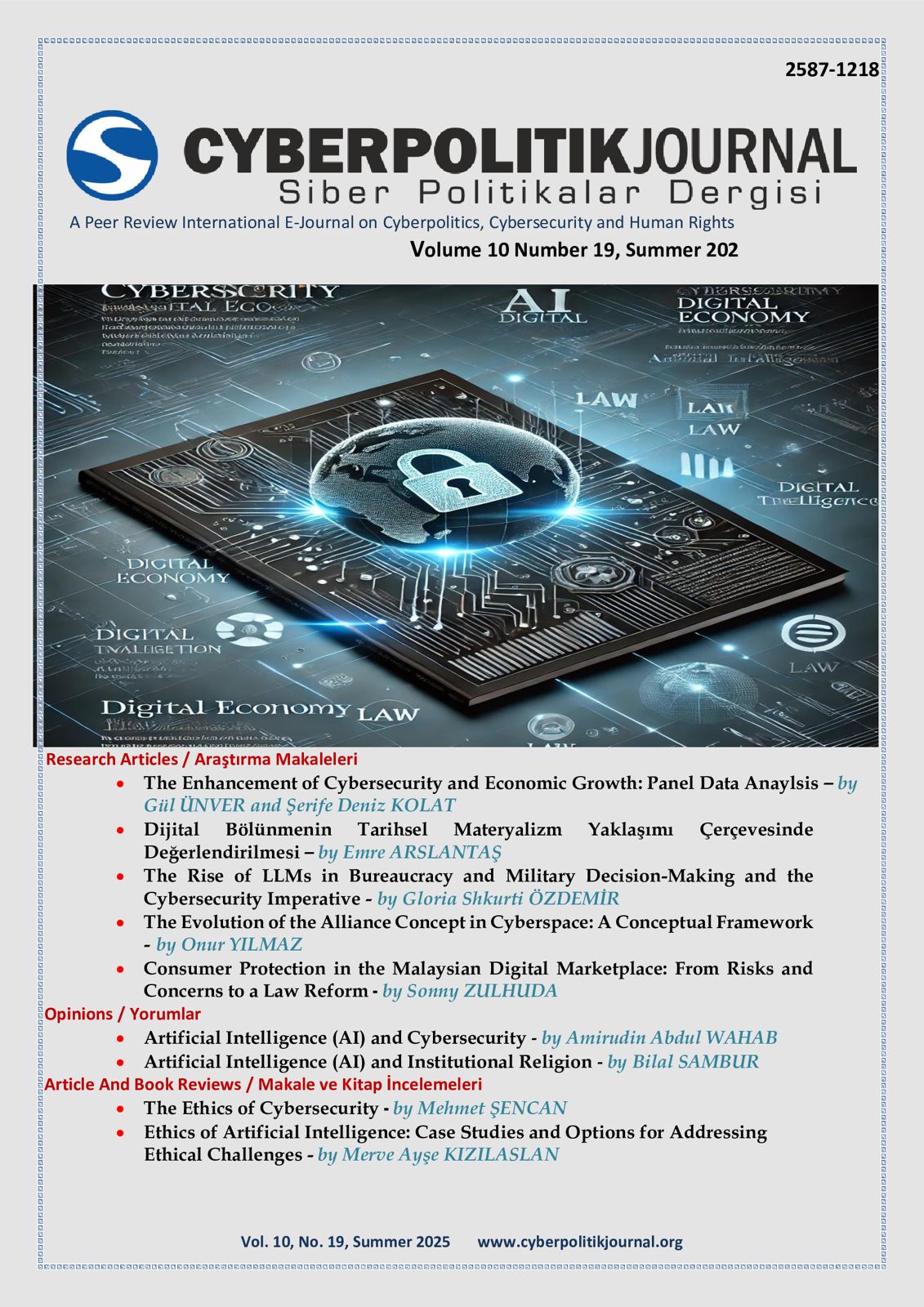THE ENHANCEMENT OF CYBERSECURITY AND ECONOMIC GROWTH: PANEL DATA ANALYSIS
Keywords:
Cybersecurity, Economic growth, Panel Data Analysis, Digital Economy, Macroeconomic EffectsAbstract
This study aims to comprehensively analyze how economic growth influences cybersecurity investments and policies in contemporary economies where digitalization is spreading at an accelerated pace. In an era characterized by mounting direct and indirect expenses stemming from cyber threats to the global economy, there is a pressing need to elucidate the correlation between cybersecurity and macroeconomic performance quantitatively. The present study examines the relationship between cybersecurity capacity and economic growth using a multidimensional nested panel data analysis method, which utilizes annual data for 171 countries in the IDI. The study also reveals that cybersecurity isn’t just a technical issue but one of the main determinants of macroeconomic stability. In nations undergoing digital transformation, cybersecurity infrastructure is as strategically significant as traditional infrastructure investments. This study examines the relationship between economic growth and cybersecurity. The findings suggest that there is a statistically significant and positive relationship between cybersecurity and economic growth. The objective of this study is to provide policymakers with strategic recommendations by highlighting the critical role of economic growth in cybersecurity, supported by quantitative data.
References
Ahmed, E. M. (2021). Modelling Information and Communications Technology Cyber Security Externalities Spillover Effects on Sustainable Economic Growth, Journal of the Knowledge Economy, (12), 412-430, https://doi.org/10.1007/s13132-020-00627-3.
Ahmed, E. M., & Ridzuan, R. (2013). The Impact of ICT on East Asian Economic Growth: Panel Estimation Approach, Journal of the Knowledge Economy, 4(4), 540-555.
Akyeşilmen, N. (2022). Cyber (In)Security in Metaverse: New Threats Old Measures?, Cyberpolitik Journal, 7 (13), 98-107.
Albiman, M. M. & Sulong, Z. (2018). Information and Communication Technology, Production and Economic Growth: A Theoretical Nexus, International Journal of Academic Research in Business and Social Sciences, 8(12), 642–657.
Appiah-Otoo, I., & Song, N. (2021). The Impact of ICT on Economic Growth-Comparing Rich
and Poor Countries, Telecommunications Policy, 45(2).
Barro, R. J., & Sala-i-Martin, X. (1992). Convergence, Journal of Political Economy, 100(2),
-251.
Benaichouba, R., Brahmi, M. & Adala, L. (2024). Economics of Cyber-Security and Society Databases: Protecting the Digital Ecosystem from Cyber-Attacks, International Journal of Professional Business Review, pp. 1-26.
Cook, R. D., Weisberg, S. (1983), “Diagnostics for Heteroscedasticity in Regression”, Biometrika, 70(1), 1-10.
Dewan, S., & Kraemer, K. L. (2000). Information Technology and Productivity: Evidence from Country-level Data, Management Science, 46(4), 548–562.
Falevich, N. (2018). Start-Up Nation Central: Finder Insights Series Israel’s Cybersecurity Industry in 2018, Start-Up Nation Central.
Fernández-Portillo, A., Almodóvar-González, M., & Hernández-Mogollón, R. (2020). Impact of ICT Development on Economic Growth, A study of OECD European Union Countries, Technology in Society, (63), https://doi.org/10.1016/j.techsoc.2020.101420.
Hausman, J. (1978) Specification Tests in Econometrics, Econometrica, (46), 1251-1271, https://doi.org/10.2307/1913827.
IBM Security (2023). Cost of a data breach report 2023, https://www.ibm.com/reports/data-breach.
ITU (2023). Measuring digital development - ICT Development Index 2023, https://www.itu.int/hub/publication/d-ind-ict_mdd-2023-2/.
ITU (2024). Measuring digital development - ICT Development Index 2024, https://www.itu.int/itu-d/reports/statistics/idi2024/.
ISACA (2022). The Human Consequences of Ransomware Attacks, https://www.isaca.org/resources/isaca-journal/issues/2022/volume-3/the-human-consequences-of-ransomware-attacks.
Kırtıllı, S. (2019). Cybersecurity and Economic Development: Comparing Developed, Developing and Emerging Economies, Cyberpolitik Journal, 4 (7), 43-69.
Miliefsky, G. (13.03.2025). The True Cost of Cybercrime: Why Global Damages Could Reach $1.2 - $1.5 Trillion by End of Year 2025, Cyber Defense Magazine, https://www.cyberdefensemagazine.com/the-true-cost-of-cybercrime-why-global-damages-could-reach-1-2-1-5-trillion-by-end-of-year-2025/.
Niebel, T. (2018). ICT and Economic Growth-Comparing Developing, Emerging and Developed Countries, World Development, (104), 197-211.
North, D.C. (1987). Institutions, Transaction Costs and Economic Growth, Economic Inquiry, 25, 419-428.
Pradhan, R. P., Arvin, M. B., Mittal, J., & Bahmani, S. (2016). Relationships Between Telecommunications Infrastructure, Capital Formation, and Economic Growth, International Journal of Technology Management, 70(2-3), 157-176.
Pradhan, R. P. (et al.) (2022). Institutional Development in an Information-Driven Economy: Can ICTs Enhance Economic Growth for Low- and Lower Middle-Income Countries?, Information Technology for Development, 28(3), 468-487.
Pimenta R.G.A. et al. (2023). Understanding Data Breach from a Global Perspective: Incident Visualization and Data Protection Law Review, Data, 9 (27), https://doi.org/10.3390/data9020027.
Rudnev, S.G., Zolkin, A.L., Artemyev, N.V., & Tychkov, A.S. (2024). The Economic Importance of Cybersecurity for Enterprises in The Context of Digital Transformation, Economika I Upravlenie: Problemy, Resheniya.
Saba, C. S. (et al.) (2024). Information and Communication Technology (ICT), Growth and Development in Developing Regions: Evidence from a Comparative Analysis and a New Approach, Journal of Knowledge Economy, (15), 14700-14748.
Shiu, A., & Lam, P. L. (2008). Causal Relationship Between Telecommunications and Economic Growth: A Study of 105 Countries, In the 17th Biennial Conference of the International Telecommunications Society, Montreal, 24-27.
Singh, H.P. & Alshammari T. S. (2020). An Institutional Theory Perspective on Developing a Cyber Security Legal Framework: A Case of Saudi Arabia, Beijing Law Review, 11(3), 637-650, https://doi.org/https://doi.org/10.4236/blr.2020.113039.
Skierka, I. (2022). When Shutdown is no Option: Identifying the Notion of the Digital Government Continuity Paradox in Estonia’s eID Crisis, Gov. Inf. Q., 40, 101781.
Stephens, K. K. (et al.) (2008). Discrete, Sequential, and Follow-Up Use of Information and Communication Technology by Experienced ICT Users, Management Communication Quarterly, 22(2), 197-231. https://doi.org/10.1177/0893318908323149.
Suzuki, R. (2024). Impact of 5GTechnology on Mobile Internet Usage in Japan, International Journal of Technology and Systems, No. 2, 9(4), 12-22.
Swamy, P. A. (1970), “Efficient Inference in a Random Coefficient Regression Model”, Econometrica: Journal of the Econometric Society, 38(2), 311-323.
Tatoğlu Yerdelen, F. (2016), “Various Approaches for the Estimation of the Three-Dimensional Fixed and Random Effect Models”, Eurasian Academy of Sciences Eurasian Econometrics, Statistics&Emprical Economics Journal, (5), 60-70.
Ünver, G. N. (2024). Comparison Of Cyber Security Policies of Türkiye And England, Cyberpolitik Journal, 8 (16), 49-84.
Yang, S., Kwon, Y., & Lee, S.T. (2020). The Impact of Information Sharing Legislation on Cybersecurity Industry, Ind. Manag. Data Syst., (120), 1777-1794.
Zaiats, D., & Kytsyuk, I. (2024). The Role of Cybersecurity in International Economic Relations, Herald UNU, International Economic Relations and World Economy, DOI: 10.32782/2413-9971/2024-53-2.
Downloads
Published
How to Cite
Issue
Section
License

This work is licensed under a Creative Commons Attribution-NonCommercial-ShareAlike 4.0 International License.









